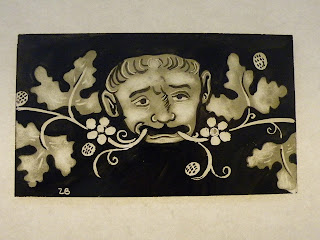The Flemish roundel that I have been studying has finally reached a stage where the border has been painted and stained.
I have taken step by step pictures of the processes that I used to keep a record of my approach to the project. I can look at my techniques and really look at what I need to do differently in the future.
The first stage was to lay my line work down. I used a brown/black mix of paint with clove oil. This was applied with a nib and also with a very fine brush. I used the nib on the more delicate areas such as the faces and brush work on the clothing.
After the line work was laid down I then placed a matting of brown/black over the whole piece. This process is easy but the correct colour to use was not. I had many attempts at mixing a colour that I felt was appropriate. The matt was laid on heavier in some areas to add depth where I needed it.
After laying down the matt that I was happy with I then began to pick out major areas on the piece that needed to be clear again; notably the background around the trees and castle. This can be more time consuming than it seems as you really don't want to go over the line work and disturb the layers. If this happens the whole thing would need to come off and be painted again.
This picture is showing the stick work in the background and also the beginning of the highlighting. I used more stick work to highlight the lightest areas, such as down the folds of the clothing and then used a softer approach with brushes to take away the rest. This process really starts to bring the painting to life.
I apply this technique across the whole piece and I also start to introduce needle work. I take a needle or a pin and I make fine marks, scratching through the paint work as another method of highlighting.
The needle work and stick work is applied all over the piece. I always start off very lightly and then go back over again where it is needed. You learn the hard way if you go in and remove too much too soon.
Above you can see a comparison with a earlier attempt. Here you can see a rather messy finish, with too many dark areas mixed with too many light. The faces and details are far too uncertain and wary. The new version has achieved much more detail, finer lines and brush work and the highlighting is much clearer and defined.
Here you can see the roundel almost at a finished stage. The central piece has had another layer of paint applied. A lavender oil mix with a brown/black paint has been placed in areas that needed to be softened and have a extra amount of depth.
The border has also been added. The border is a Lamberts tint glass and has had several techniques applied to it. Firstly I needed to cartoon the border, this was a task I thought would be easy but turned out to be difficult due to my need to fuss! I also wanted to make this roundel appear to have just been made. My goal was to create a finish like it would have been when it was first made in the 15th century. The original has some visible paint loss.
The border has been pooled in a dark black/brown mix and has then had stick work and shading applied. The shading is a lavender oil black/brown mix and softened out with a medium badger brush.
The centre piece was then silver stained to finish it off. This is applied to the back of the glass and is placed where you want the yellow to show through. The glass that I used was an antique and unfortunately it would not take the silver stain in certain areas. I attempted several times with no luck so I am left with no stain the the central fore ground.































